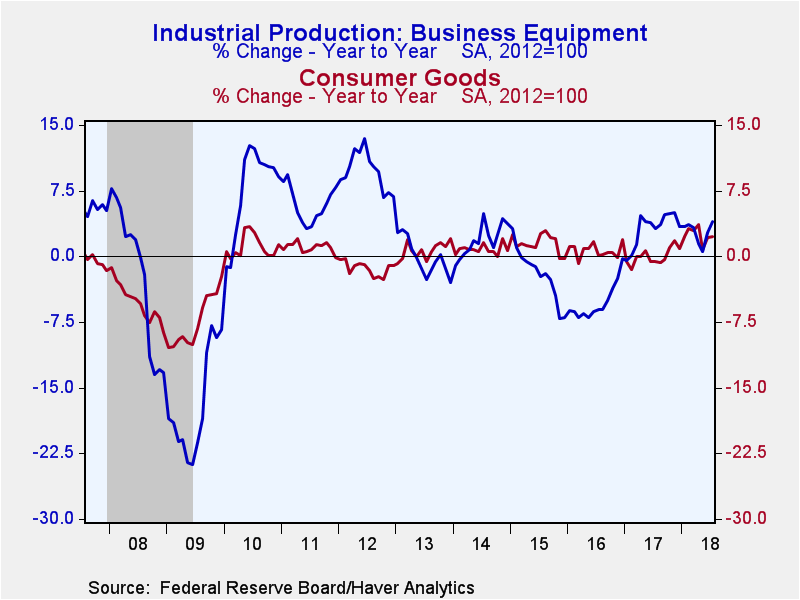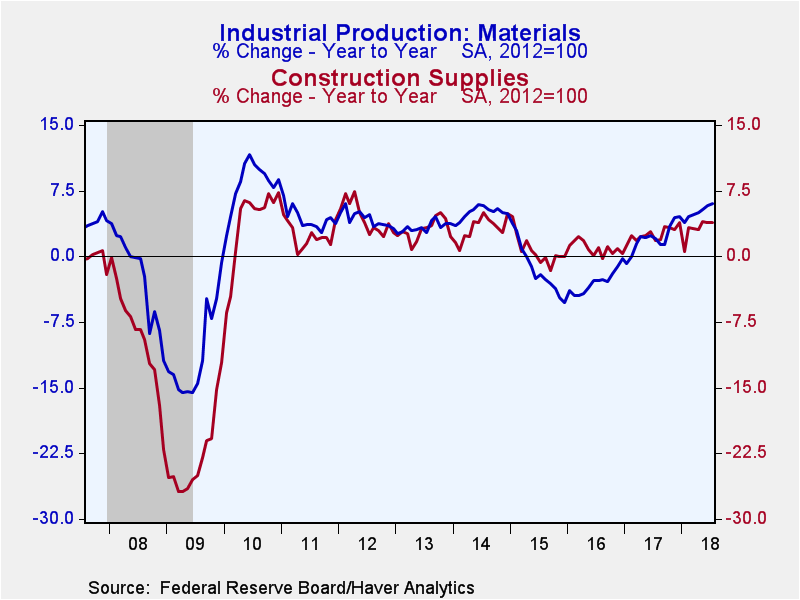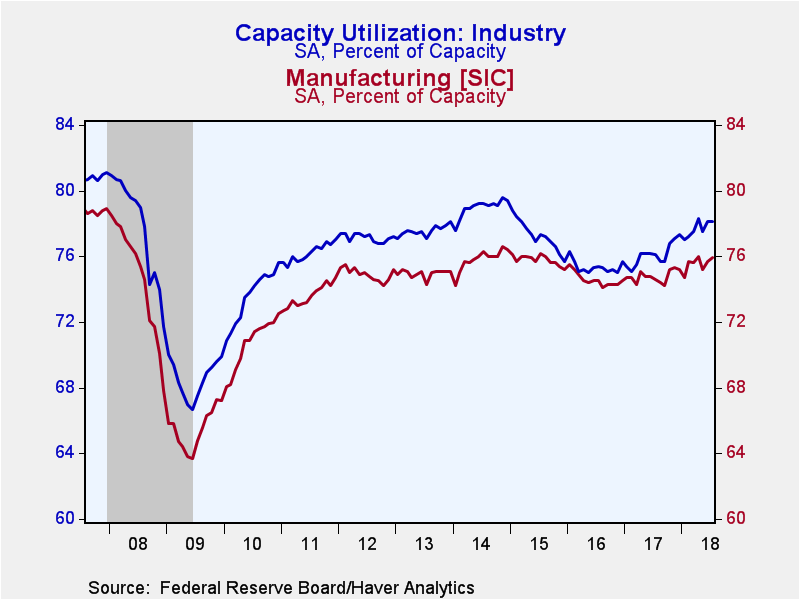 Global| Aug 15 2018
Global| Aug 15 2018U.S. Industrial Production Softer in July on Weaker Utilities Output
by:Sandy Batten
|in:Economy in Brief
Summary
Industrial production edged up 0.1% m/m (4.2% y/y) in July but the 0.6% m/m rise initially reported for June was revised up to a sturdy 1.0% m/m increase. The consensus from the Action Economics Survey had looked for a 0.3% m/m gain. [...]
Industrial production edged up 0.1% m/m (4.2% y/y) in July but the 0.6% m/m rise initially reported for June was revised up to a sturdy 1.0% m/m increase. The consensus from the Action Economics Survey had looked for a 0.3% m/m gain. The softness in July was due largely to an unexpected 0.5% m/m decline (+2.4% y/y) in utilities production (the third consecutive monthly decline) along with a 0.3% m/m drop (+12.9% y/y) in mining activity. This was only the third monthly decline in mining output in the past 12 months. Manufacturing output was up a solid 0.3% m/m (2.9% y/y) in July.
The rise in manufacturing output was led by a 0.8% m/m (4.0% y/y) rise in the production of business equipment. This increase was widespread across major categories with output of transit equipment up 1.8% m/m, information processing equipment up 1.1% m/m, and industrial equipment up 0.1%. The production of oil and gas well drilling equipment slumped 3.4% m/m.
Consumer goods production was unchanged (+2.3% y/y) in July with output of consumer durables rising 0.2% m/m while output of nondurables was unchanged. Output of motor vehicles increased a sturdy 1.0% m/m but this was a sharp slowdown from the 7.6% m/m surge in June (which was a rebound from the 8.5% m/m collapse in May).
The production of construction supplies slid 0.1% m/m (+3.9% y/y) in July, their fourth monthly decline in the past seven months. Materials output edged up 0.1% m/m in July to be 6.0% above year-ago levels.
The drop in utilities output, dictated largely by the weather, was due entirely to a 0.9% m/m decline in electric power generation. Natural gas distribution rose 2.2% m/m. Output of energy slipped 0.2% m/m in July but the growth from a year earlier was a robust 8.3%.
In the special aggregate groupings, production in selected high-technology industries slowed to a still-solid 0.8% m/m increase from the 1.9% m/m jump in June. Non-energy production excluding high-tech advanced a modest 0.2% m/m in July following a 0.8% m/m gain in June. Factory sector production excluding both high-tech and autos improved 0.2% m/m, the same monthly rise as in June.
Capacity utilization was unchanged at 78.1% in July. This is well off the recession low of 66.7% in 2009 but still meaningfully below the pre-recession peak of 81.0% in 2007. Factory sector capacity utilization improved to 75.9% in July from 75.7% in June.
Industrial production and capacity data are included in Haver's USECON database, with additional detail in the IP database. The expectations figure is in the AS1REPNA database.
| Industrial Production (SA, % Change) | Jul | Jun | May | Jul Y/Y | 2017 | 2016 | 2015 |
|---|---|---|---|---|---|---|---|
| Total Output | 0.1 | 1.0 | -0.8 | 4.2 | 1.6 | -2.0 | -1.0 |
| Manufacturing | 0.3 | 0.8 | -0.9 | 2.9 | 1.2 | -0.8 | -0.6 |
| Consumer Goods | 0.0 | 0.9 | -2.5 | 2.3 | 0.0 | 0.7 | 1.5 |
| Business Equipment | 0.8 | 2.2 | -1.9 | 4.0 | 3.2 | -5.3 | -2.0 |
| Construction Supplies | -0.1 | -0.3 | 0.3 | 3.9 | 2.5 | 0.9 | 0.6 |
| Materials | 0.1 | 1.0 | 0.2 | 6.0 | 2.0 | -3.0 | -1.5 |
| Utilities | -0.5 | -0.7 | -2.6 | 2.4 | -1.3 | -0.4 | -0.8 |
| Mining | -0.3 | 2.9 | 0.8 | 12.9 | 6.4 | -9.7 | -3.4 |
| Capacity Utilization (%) | 78.1 | 78.1 | 77.5 | 76.1 | 76.1 | 75.4 | 77.3 |
| Manufacturing | 75.9 | 75.7 | 75.2 | 74.6 | 74.8 | 74.6 | 75.8 |
Sandy Batten
AuthorMore in Author Profile »Sandy Batten has more than 30 years of experience analyzing industrial economies and financial markets and a wide range of experience across the financial services sector, government, and academia. Before joining Haver Analytics, Sandy was a Vice President and Senior Economist at Citibank; Senior Credit Market Analyst at CDC Investment Management, Managing Director at Bear Stearns, and Executive Director at JPMorgan. In 2008, Sandy was named the most accurate US forecaster by the National Association for Business Economics. He is a member of the New York Forecasters Club, NABE, and the American Economic Association. Prior to his time in the financial services sector, Sandy was a Research Officer at the Federal Reserve Bank of St. Louis, Senior Staff Economist on the President’s Council of Economic Advisors, Deputy Assistant Secretary for Economic Policy at the US Treasury, and Economist at the International Monetary Fund. Sandy has taught economics at St. Louis University, Denison University, and Muskingun College. He has published numerous peer-reviewed articles in a wide range of academic publications. He has a B.A. in economics from the University of Richmond and a M.A. and Ph.D. in economics from The Ohio State University.










